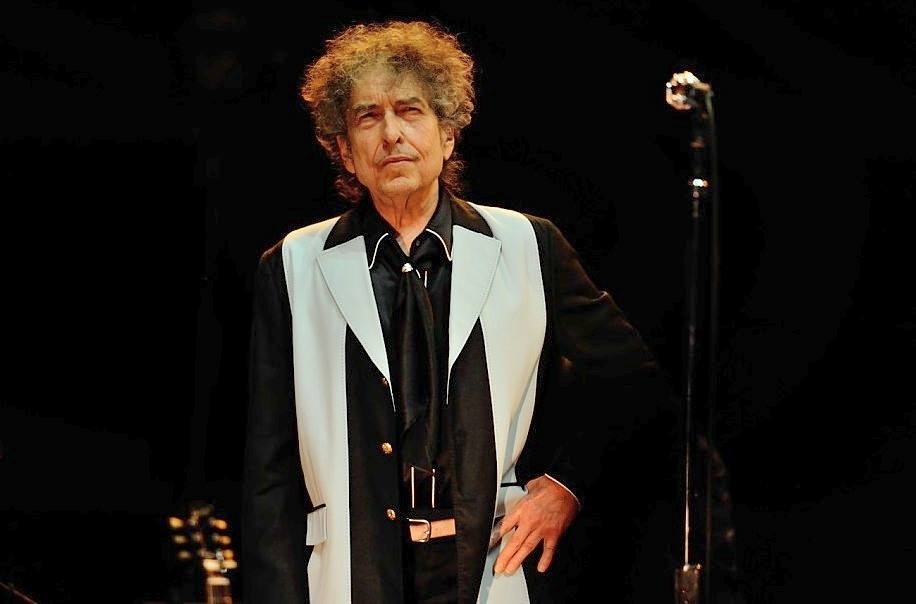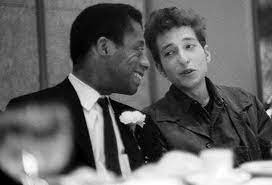
Congratulations to Bob Dylan as this year’s winner of the Nobel Prize in Literature. When I heard the news this morning, I thought well of the Nobel Committee for honoring a “literary” figure whose work is widely known, and a musician so deeply tied to the word through oral tradition, folklore, popular culture, and the Holy Bible. I’m in ready accord with David Hajdu, who told The New York Times, “It’s partly a recognition of the whole tradition that Bob Dylan represents, so it’s a retroactive award for Robert Johnson and Hank Williams and Smokey Robinson and the Beatles.” Does the Nobel top the honor Dylan received in 2012 when President Obama presented him with the Presidential Medal of Freedom? At the time, Obama said, “Bob’s voice, with its weight, its unique, gravelly power, redefined not just what music sounded like, but the message it carried.”
Of course, when it comes to Bob Dylan, message is a complex thing. The erstwhile Greenwich Village folkie long ago rejected the notion of himself as a protest singer representing the civil rights or anti-war movements, and in that he can be seen as an American artist resisting the requirements of ideology and collectivist thinking. I hear Dylan’s quintessential American voice as two-fold: his fierce individuality reflects the drive to go one’s own way, and in drawing on both the canon of Western literature and the American vernacular, he’s blurred what Lawrence Levine calls the “highbrow/lowbrow” dichotomies of American culture. It’s from there that his message emanates, rocks, and resounds.
While the Nobel honors Dylan for his brilliance, uniqueness, and innovation as a songwriter, his literary gifts are also evident in the superb memoir he published in 2004. I reviewed Chronicles, Volume One, for Downbeat and noted that while I’d spent many an hour listening and reading and contemplating the enigmatic “voice of my generation,” I was completely surprised by the degree to which jazz figures in the 293-page prose epic. Ironically, it’s Dylan, more than any other artist– the Beatles are a close second, but their music got deep after Bob– whose work eroded the status of jazz as the music of a hip elite in the post-World War II years. So while he’ll never be regarded as a contributor to jazz (even with his recent albums of Sinatra-associated ballads), the music had a profound impact on him personally.
Once he arrived in New York in 1961, Dylan became immersed in the Greenwich Village folk scene, but jazz was all over lower Manhattan too. He credits Dave Von Ronk with taking him around to the Village Vanguard, Village Gate, and other venues “where I got to see a lot of the jazz greats close up.” He recounts playing the spiritual “The Water Is Wide” with avant-gardist Cecil Taylor who, he says, “could play regular piano if he wanted to,” and on another occasion at the same venue, “a creepy but convenient little coffeehouse on Bleeker,” he played with drummer Billy Higgins and trumpeter Don Cherry of the Ornette Coleman Quartet. (Dylan’s early producer at Columbia was Tom Wilson, a black Texan who founded Transition Records in Boston in 1956. Wilson produced Cecil Taylor’s debut release Jazz Advance and sessions on Sun Ra and Yusef Lateef.)
Dylan recalls seeing Thelonious Monk at the Five Spot. “Sometimes he’d be in there in the afternoon sitting at the piano all alone playing stuff that sounded like Ivory Joe Hunter– a big half eaten sandwich left on top of his piano. I dropped in there once in the afternoon, just to listen– told him that I played folk music up the street. ‘We all play folk music,’ he said. Monk was in his own dynamic universe even when he dawdled around. Even then, he summoned magic shadows into being.”
He mentions numerous jazz records, including fairly obscure Duke Ellington works like “Tourist Point of View” and “The Tattooed Bride,” and Gil Evans’s recording of “Ella Speed,” a song by Leadbelly. “If I needed to wake up real quick, I’d put on ‘Swing Low, Sweet Cadillac’ or ‘Umbrella Man’ by Dizzy Gillespie. ‘Hot House’ by Charlie Parker [from the 1953 Massey Hall Concert, I’d guess] was a good record to wake up to. There were a few souls around who had heard and seen Parker play and it seemed like he had transmitted some secret essence of life to them.”

Dylan is rapturous over Harold Arlen, Harry Belafonte, and Frank Sinatra. “In Harold’s songs…the cosmic ‘Somewhere Over the Rainbow’…I could hear rural blues and folk music.” Dylan’s obvious models were Woody Guthrie, Hank Williams, and Muddy Waters, but “I could never escape from the bittersweet, lonely intense world of Harold Arlen.” Of Belafonte, he writes, “He had ideals and made you feel you’re part of the human race…that rare type of character that radiates greatness, and you hope some of it rubs off on you…You know he never took the easy path, though he could have.” He’s downright hyperbolic about Sinatra’s recording of “Ebb Tide,” exclaiming, “I could hear everything in his voice– death, God, the universe, everything.”
Even though Bitches Brew wasn’t released until several years after Dylan went electric, he relates the controversy he instigated to the one surrounding the plugged-in Miles. Dylan describes it as “a piece of music that didn’t follow the rules of modern jazz, which had been on the verge of breaking into the popular marketplace until Miles’s record came along and killed its chances. Miles was put down by the jazz community. I couldn’t imagine Miles being too upset.” The popular marketplace claim suggests he’s compressed the timeline between the mid-sixties success of “The Girl From Ipanema” and “Hello Dolly” and Miles’s late-sixties venture in jazz-rock fusion.

Not surprisingly, he’s passionate about Robert Johnson, devoting several pages to the mythical bluesman and the stunning impact of hearing King of the Delta Blues Singers, the 1962 album of Johnson’s 1936-’37 recordings. “From the first note the vibrations from the loudspeaker made my hair stand up…When Johnson started singing, he seemed like a guy who could have been sprung from the head of Zeus in full armor…The songs weren’t customary blues songs. They were perfected pieces…They were so utterly fluid…short punchy verses that resulted in some panoramic story…fires of mankind blasting off the surface of this spinning piece of plastic.” Upon seeing the photographs of Johnson that were first published in the early nineties, he writes, “He looks nothing like a man of stone, no high-strung temperament…wearing an unusual gilded cap like Little Lord Fauntleroy. He looks nothing like a man with a hellhound on his trail. He looks immune to human dread and you stare at the image in disbelief.”

In the book’s only passage devoted to technique, he credits Lonnie Johnson, albeit cryptically, with showing him a guitar style that was “more active with more definition of presence…I had the idea he was showing me something secretive.” Sonny Boy Williamson heard him play harmonica in John Lee Hooker’s hotel room and told him, “Boy, you play too fast.” Blues harp experts might say the irascible Sonny Boy was being unusually kind.
Robert Zimmerman’s adoption of the name Bob Dylan is tied not only to Dylan Thomas, but, in typically convoluted fashion, to jazz singer Dave Allyn, whom he otherwise misidentifies as a saxophonist. Apparently the “y” in Allyn’s name impressed Dylan before he encountered the Welsh poet.

Most revealing, in a tale that echoes James Baldwin’s writings about how blacks often provide whites clues to their own identities, he describes a dream-like odyssey in which he leaves a San Rafael, California, rehearsal session in complete dejection only to wander into a barroom where an unnamed jazz singer and combo are performing.
“Something was calling me to come in and I entered, walked along the long, narrow bar to where the jazz cats were playing in the back on a raised platform in front of a brick wall. I got within four feet of the stage and just stood there against the bar, ordered a gin and tonic and faced the singer. An older man, he wore a mohair suit, flat cap with a little brim and a shiny necktie. The drummer had a rancher’s Stetson on and the bassist and pianist were neatly dressed. They played jazz ballads, stuff like ‘Time on My Hands’ and ‘Gloomy Sunday.’ The singer reminded me of Billy Eckstine. He wasn’t forceful, but he didn’t have to be; he was relaxed, but he sang with natural power. Suddenly and without warning, it was like the guy had an open window to my soul. It was like he was saying, ‘You should do it this way.’
“All of a sudden, I understood something faster than I ever did before. I could feel how he worked at getting his power, what he was doing to get at it. I knew where the power was coming from and it wasn’t his voice, though the voice brought me sharply back to myself. I used to do this thing, I’m thinking. It was a long time ago and it had been automatic. No one had ever taught me. This technique was so elemental, so simple and I’d forgotten. It was like I’d forgotten how to button my pants. I wondered if I could still do it. I wanted at least a chance to try. If I could in any way get close to handling this technique, I could get off this marathon stunt ride…This was revelatory…I had that old jazz singer to thank.”

Notwithstanding his great work of the sixties and seventies, it’s doubtful that the high degree of official recognition lately accorded Bob would have occurred without the return to form he’s displayed over the past twenty years. Beginning with Time Out of Mind in 1997, followed by Love and Theft in 1999 and Modern Times in 2003, Dylan’s creative rebirth has found him drawing deeply on show biz tropes, dystopian visions, Delta blues mythology, and the humbling advance of late middle-age. That “old jazz singer” showed him the way.